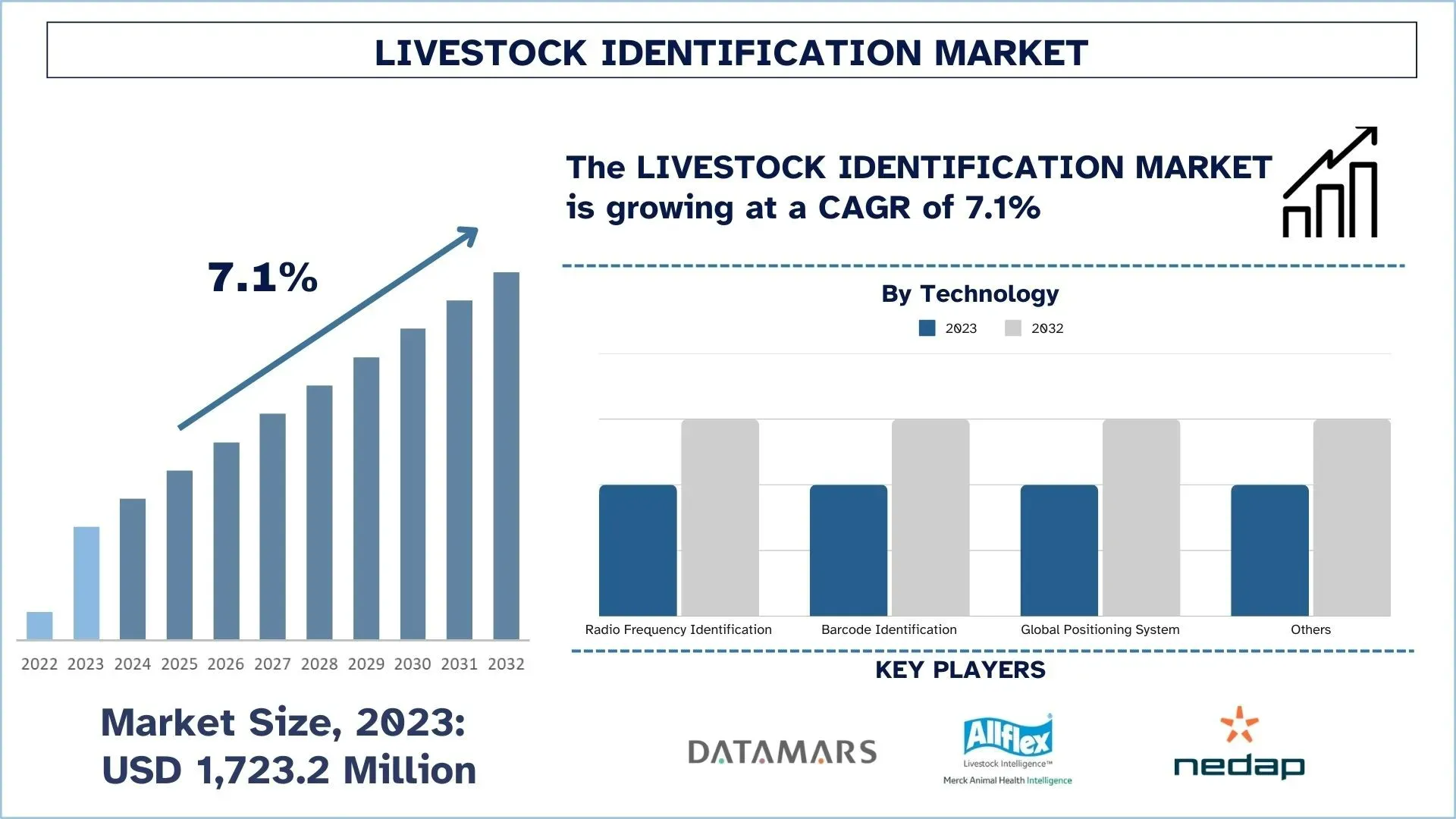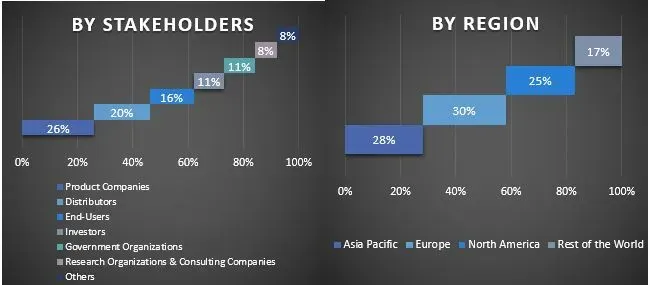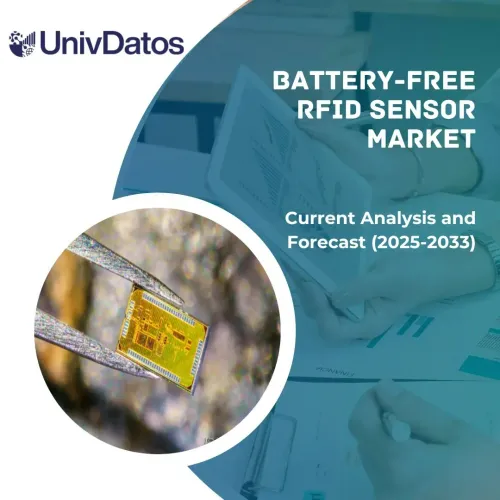- Trang chủ
- Về chúng tôi
- Ngành
- Dịch vụ
- Đọc
- Liên hệ với chúng tôi
Thị trường Nhận dạng Vật nuôi: Phân tích và Dự báo Hiện tại (2024-2032)
Nhấn mạnh vào Công nghệ (Nhận dạng Tần số Vô tuyến, Nhận dạng Mã vạch, Hệ thống Định vị Toàn cầu và Các loại khác); Người dùng Cuối (Gia súc, Heo, Gia cầm và Cừu & Dê); Khu vực/Quốc gia.

Quy mô & Dự báo Thị trường Nhận dạng Vật nuôi
Thị trường Nhận dạng Vật nuôi được định giá 1.723,2 Triệu USD vào năm 2023 và dự kiến sẽ tăng trưởng với tốc độ CAGR mạnh mẽ khoảng 7,1% trong giai đoạn dự báo (2024-2032) do các quy định nghiêm ngặt của chính phủ về truy xuất nguồn gốc và kiểm soát dịch bệnh, cùng với việc ngày càng có nhiều người áp dụng RFID và theo dõi dựa trên IoT để quản lý đàn hiệu quả.
Phân tích Thị trường Nhận dạng Vật nuôi
Thị trường nhận dạng thuộc tính vật nuôi phát triển khi ngành chăn nuôi tập trung nhiều hơn vào việc phát hiện dịch bệnh và đáp ứng các quy tắc của chính phủ. Thị trường này bao gồm các công nghệ giúp các nhà khai thác duy trì quyền kiểm soát liên tục vật nuôi từ đầu đến cuối vòng đời của chúng trong khi bảo vệ sức khỏe động vật và cải thiện hiệu quả chuỗi cung ứng. Ngành chăn nuôi cần theo dõi động vật nhiều hơn vì mọi người muốn nhiều thực phẩm hơn từ động vật, cộng với công nghệ mới giúp cải thiện việc nhận dạng, cộng với việc chính phủ yêu cầu hồ sơ theo dõi động vật hoàn chỉnh.
Trong những năm tới, khu vực Châu Á Thái Bình Dương sẽ mở rộng thị trường với tốc độ nhanh nhất. Nhu cầu thị trường thịt ở Trung Quốc, Ấn Độ, Úc và Nhật Bản tăng lên khi số lượng vật nuôi của họ tăng lên. Ví dụ, Ấn Độ có số lượng gia súc lớn nhất thế giới vào năm 2023, tiếp theo là Brazil và Trung Quốc. Tồn kho gia súc của Ấn Độ được báo cáo là 307,5 triệu con vào năm 2023, chiếm khoảng 33% tổng số hàng tồn kho của thế giới. Ngành chăn nuôi đang mở rộng, cùng với việc chủ sở hữu tài sản có thêm kiến thức về phần mềm theo dõi vật nuôi, thu hút những người mua tiềm năng. Trung Quốc và Ấn Độ sẽ là những quốc gia có tốc độ tăng trưởng nhanh nhất trong khu vực trong giai đoạn dự báo.
Xu hướng Thị trường Nhận dạng Vật nuôi
Phần này thảo luận về các xu hướng thị trường chính đang ảnh hưởng đến các phân khúc khác nhau của thị trường Nhận dạng Vật nuôi do nhóm các chuyên gia nghiên cứu của chúng tôi xác định.
Quy định & Tuân thủ của Chính phủ
Các chính phủ trên khắp các quốc gia hiện yêu cầu khung để theo dõi vật nuôi của họ để đảm bảo an toàn thực phẩm và ngăn chặn dịch bệnh trong khi đáp ứng các tiêu chuẩn thương mại quốc tế. Nhiều quốc gia yêu cầu NAIS ở Hoa Kỳ, Hệ thống Nhận dạng Vật nuôi Mở rộng ở Châu Âu và Chương trình Phát triển Chăn nuôi ở Ấn Độ để theo dõi động vật thông qua thẻ RFID, thẻ tai và hệ thống sinh trắc học. Chính phủ đặt ra các quy tắc giám sát dịch bệnh và tiêu chuẩn truy xuất nguồn gốc cung ứng cùng với các thành phần ngăn chặn trộm cắp, giúp thị trường tăng trưởng.
Áp dụng Theo dõi dựa trên RFID & IoT
Hệ thống theo dõi RFID và IoT kết hợp để cải thiện quản lý vật nuôi bằng cách hiển thị dữ liệu trực tiếp và đo lường tự động với các chi tiết theo dõi động vật chính xác. Nông dân sử dụng thẻ RFID và cảm biến để kiểm tra các dấu hiệu sức khỏe, ghi lại vị trí của động vật và theo dõi đường đi của chúng, điều này cắt giảm khối lượng công việc và tăng cường kết quả. Công nghệ IoT được kết nối làm việc với hệ thống đám mây giúp phát hiện sớm bệnh, giúp quá trình sản xuất vật nuôi hiệu quả và thân thiện với môi trường hơn.
Kiểm soát Dịch bệnh & Các biện pháp An toàn sinh học
Các bệnh ở vật nuôi như Bệnh lở mồm long móng (FMD), Bệnh lao bò và Cúm gia cầm gây ra những rủi ro nghiêm trọng đối với sức khỏe động vật và an toàn thực phẩm. Các tổ chức công cộng và nông dân chăn nuôi bò theo dõi bệnh tật nhanh chóng bằng các công cụ mới để kiểm soát sự lây lan trước khi nó trở nên lớn hơn. Một hệ thống nhận dạng động vật nhanh chóng giúp phát hiện vật nuôi bị nhiễm bệnh, điều này giúp tiết kiệm thị trường trên toàn thế giới và giảm chi phí công nghiệp.
Nhu cầu ngày càng tăng đối với các sản phẩm Thịt & Sữa
Nhu cầu về các mặt hàng chăn nuôi tăng lên khi xã hội toàn cầu mở rộng và mọi người áp dụng các mô hình ăn uống mới, đặc biệt là ở các nước đang phát triển như Trung Quốc, Ấn Độ và Brazil. Các doanh nghiệp hiện đang điều hành các hoạt động sản xuất thịt và sữa quy mô lớn, cần các hệ thống theo dõi động vật tiên tiến để duy trì các tiêu chuẩn chất lượng và đạt được kết quả tốt hơn. Khách hàng muốn biết vật nuôi của họ đến từ đâu và chúng được nuôi như thế nào, điều này dẫn đến việc các công ty sử dụng hệ thống theo dõi để hiển thị thông tin này.

APAC Dự kiến sẽ Tăng trưởng với CAGR đáng kể trong Giai đoạn Dự báo
Khu vực Châu Á - Thái Bình Dương cho thấy sự tăng trưởng mạnh mẽ trong hệ thống nhận dạng vật nuôi của mình vì số lượng động vật và nhu cầu về thịt-sữa đang tăng lên, cộng với chính quyền khu vực yêu cầu các hệ thống theo dõi. Một số quốc gia, đặc biệt là Trung Quốc, Ấn Độ, Úc và New Zealand, dẫn đầu bằng cách thông qua các luật khắc nghiệt để kiểm tra an toàn thực phẩm và sức khỏe động vật. Nông dân và các thành viên trong ngành chọn thẻ RFID và công nghệ Internet of Things vì các hệ thống này giúp họ điều hành đàn của mình thông minh và tốt hơn. Trớ trêu thay, sự mở rộng thị trường trong khu vực này đến từ hai lực lượng khác nhau. Một đến từ việc tăng cường sử dụng công nghệ kỹ thuật số trong nông nghiệp và lực lượng còn lại phát triển do các ưu đãi tài chính do chính phủ cung cấp cho thiết bị nhận dạng động vật.
Trung Quốc và Ấn Độ là những nhà sản xuất thịt và sữa hàng đầu toàn cầu, vì vậy nhu cầu thị trường về các công cụ theo dõi ngày càng mạnh mẽ hơn. Xuất khẩu gia súc đã được thiết lập từ Úc và sản xuất sữa ở New Zealand thúc đẩy sự phát triển của thị trường này. Các công ty khởi nghiệp công nghệ khác nhau ở APAC tạo ra các giải pháp mới sử dụng giám sát AI để theo dõi vật nuôi, cộng với blockchain để lưu giữ hồ sơ chuỗi cung ứng. Lĩnh vực nhận dạng vật nuôi trên khắp APAC sẽ tiếp tục mở rộng vì các quy tắc an toàn thực phẩm nghiêm ngặt hơn và kỳ vọng của người mua sản phẩm có đạo đức ngày càng tăng.

Bối cảnh cạnh tranh của Ngành Nhận dạng Vật nuôi
Thị trường Nhận dạng Vật nuôi có tính cạnh tranh và phân mảnh, với sự hiện diện của một số người chơi thị trường toàn cầu và quốc tế. Những người chơi chính đang áp dụng các chiến lược tăng trưởng khác nhau để tăng cường sự hiện diện trên thị trường của họ, chẳng hạn như quan hệ đối tác, thỏa thuận, hợp tác, ra mắt sản phẩm mới, mở rộng địa lý và sáp nhập và mua lại.
Các Công ty Sản xuất Kính Kháng khuẩn Hàng đầu
Một số nhà cung cấp chính đang hoạt động trên thị trường bao gồm Datamars, Allflex Livestock Intelligence (Merck Animal Health), Nedap N.V., Shearwell Data Ltd., CAISLEY International GmbH, Kupsan Tag Company Ltd., Luoyang Laipson Information Technology Co., Ltd., Y-Tex Corporation, Leader Products và OMNIA Technologies Pvt. Ltd.
Tin tức Thị trường Nhận dạng Vật nuôi
Năm 2023, Datamars, công ty giải pháp quản lý RFID và vật nuôi toàn cầu và Connecterra, một công ty dẫn đầu về công nghệ dữ liệu và AI, đã công bố quan hệ đối tác chiến lược. Thông qua khoản đầu tư của mình, Datamars đã mua lại mảng kinh doanh cảm biến của Connecterra được gọi là 'Ida for Farmers' và cũng sẽ nắm giữ cổ phần đa số trong công ty Connecterra. Connecterra sẽ vẫn độc lập và tập trung vào việc phát triển hơn nữa nền tảng Enterprise của mình. Khoản đầu tư tận dụng thế mạnh của từng công ty để thúc đẩy hơn nữa quá trình chuyển đổi của ngành sang chăn nuôi bò sữa bền vững hơn bằng cách hỗ trợ các nhà sản xuất trên toàn cầu đang phải đối mặt với áp lực ngày càng tăng để sản xuất nhiều hơn, ít tác động hơn.
Phạm vi Báo cáo Thị trường Nhận dạng Vật nuôi
Thuộc tính Báo cáoe | Chi tiết |
Năm cơ sở | 2023 |
Thời gian dự báo | 2024-2032 |
Động lực tăng trưởng | Tăng tốc với CAGR 7,1% |
Quy mô thị trường năm 2023 | 1.723,2 Triệu USD |
Phân tích theo khu vực | Bắc Mỹ, Châu Âu, APAC, Phần còn lại của Thế giới |
Khu vực đóng góp chính | Châu Á - Thái Bình Dương dự kiến sẽ tăng trưởng với CAGR cao nhất trong giai đoạn dự báo |
Các quốc gia chính được đề cập | Hoa Kỳ, Canada, Đức, Tây Ban Nha, Ý, Pháp, Vương quốc Anh, Trung Quốc, Nhật Bản, Úc và Ấn Độ |
Các công ty được giới thiệu | Datamars, Allflex Livestock Intelligence (Merck Animal Health), Nedap N.V., Shearwell Data Ltd., CAISLEY International GmbH, Kupsan Tag Company Ltd., Luoyang Laipson Information Technology Co., Ltd., Y-Tex Corporation, Leader Products và OMNIA Technologies Pvt. Ltd. |
Phạm vi báo cáo | Xu hướng, Động lực và Hạn chế của Thị trường; Ước tính và Dự báo Doanh thu; Phân tích phân khúc; Phân tích Cung và Cầu; Bối cảnh cạnh tranh; Lập hồ sơ công ty |
Các phân khúc được đề cập | Theo Công nghệ; Theo Người dùng cuối; Theo Khu vực/Quốc gia |
Lý do mua báo cáo này:
Nghiên cứu bao gồm phân tích định cỡ và dự báo thị trường được xác nhận bởi các chuyên gia chủ chốt trong ngành.
Báo cáo trình bày một bản xem nhanh về hiệu suất tổng thể của ngành.
Báo cáo bao gồm phân tích chuyên sâu về các đối tác trong ngành nổi bật, tập trung chủ yếu vào các yếu tố tài chính kinh doanh chính, danh mục sản phẩm, chiến lược mở rộng và những phát triển gần đây.
Phân tích chi tiết về các động lực, hạn chế, xu hướng chính và cơ hội hiện có trong ngành.
Nghiên cứu bao gồm toàn diện thị trường trên các phân khúc khác nhau.
Phân tích cấp độ khu vực chuyên sâu của ngành.
Tùy chọn tùy chỉnh:
Thị trường Nhận dạng Gia súc toàn cầu có thể được tùy chỉnh thêm theo yêu cầu hoặc bất kỳ phân khúc thị trường nào khác. Bên cạnh đó, UMI hiểu rằng bạn có thể có nhu cầu kinh doanh riêng, do đó, vui lòng liên hệ với chúng tôi để nhận báo cáo hoàn toàn phù hợp với yêu cầu của bạn.
Mục lục
Phương pháp Nghiên cứu để Phân tích Thị trường Nhận dạng Gia súc (2024-2032)
Phân tích thị trường lịch sử, ước tính thị trường hiện tại và dự báo thị trường tương lai của Nhận dạng Gia súc toàn cầu là ba bước chính được thực hiện để tạo và khám phá việc áp dụng Nhận dạng Gia súc ở các khu vực chính trên toàn cầu. Nghiên cứu thứ cấp chuyên sâu đã được tiến hành để thu thập các số liệu thị trường lịch sử và ước tính quy mô thị trường hiện tại. Thứ hai, nhiều phát hiện và giả định đã được xem xét để xác nhận những hiểu biết sâu sắc này. Hơn nữa, các cuộc phỏng vấn chính chuyên sâu cũng được thực hiện với các chuyên gia trong ngành trên toàn bộ chuỗi giá trị của thị trường Nhận dạng Gia súc toàn cầu. Sau khi giả định và xác nhận các số liệu thị trường thông qua các cuộc phỏng vấn chính, chúng tôi đã sử dụng phương pháp top-down/bottom-up để dự báo quy mô thị trường hoàn chỉnh. Sau đó, các phương pháp phân tích và tam giác hóa dữ liệu thị trường đã được áp dụng để ước tính và phân tích quy mô thị trường của các phân khúc và phân đoạn phụ của ngành. Phương pháp chi tiết được giải thích dưới đây:
Phân tích Quy mô Thị trường Lịch sử
Bước 1: Nghiên cứu chuyên sâu về các Nguồn thứ cấp:
Một nghiên cứu thứ cấp chi tiết đã được tiến hành để có được quy mô thị trường lịch sử của Nhận dạng Gia súc thông qua các nguồn nội bộ của công ty nhưbáo cáo thường niên & báo cáo tài chính, thuyết trình về hiệu suất, thông cáo báo chí, v.v.,và các nguồn bên ngoài bao gồmtạp chí, tin tức & bài báo, ấn phẩm chính phủ, ấn phẩm của đối thủ cạnh tranh, báo cáo ngành, cơ sở dữ liệu của bên thứ ba và các ấn phẩm đáng tin cậy khác.
Bước 2: Phân khúc thị trường:
Sau khi có được quy mô thị trường lịch sử của Nhận dạng Gia súc, chúng tôi đã tiến hành phân tích thứ cấp chi tiết để thu thập thông tin chi tiết về thị trường lịch sử và chia sẻ cho các phân khúc và phân đoạn phụ khác nhau cho các khu vực chính. Các phân khúc chính được bao gồm trong báo cáo, chẳng hạn như Công nghệ và Người dùng cuối. Phân tích cấp quốc gia hơn nữa đã được thực hiện để đánh giá việc áp dụng tổng thể các mô hình thử nghiệm trong khu vực đó.
Bước 3: Phân tích yếu tố:
Sau khi có được quy mô thị trường lịch sử của các phân khúc và phân đoạn phụ khác nhau, chúng tôi đã tiến hành một phân tích chi tiếtphân tích yếu tốđể ước tính quy mô thị trường hiện tại của Nhận dạng Gia súc. Hơn nữa, chúng tôi đã tiến hành phân tích yếu tố bằng cách sử dụng các biến phụ thuộc và độc lập như Công nghệ và Người dùng cuối của thị trường Nhận dạng Gia súc. Một phân tích kỹ lưỡng đã được thực hiện về các kịch bản cung và cầu có tính đến các quan hệ đối tác hàng đầu, sáp nhập và mua lại, mở rộng kinh doanh và ra mắt sản phẩm trong lĩnh vực Nhận dạng Gia súc trên toàn cầu.
Ước tính & Dự báo Quy mô Thị trường Hiện tại
Định cỡ thị trường hiện tại:Dựa trên những hiểu biết sâu sắc có thể hành động từ 3 bước trên, chúng tôi đã đi đến quy mô thị trường hiện tại, các đối thủ chính trên thị trường Nhận dạng Gia súc toàn cầu và thị phần của các phân khúc. Tất cả các phân chia phần trăm chia sẻ cần thiết và phân tích thị trường đã được xác định bằng cách sử dụng phương pháp thứ cấp được đề cập ở trên và đã được xác minh thông qua các cuộc phỏng vấn chính.
Ước tính & Dự báo:Để ước tính và dự báo thị trường, trọng số đã được gán cho các yếu tố khác nhau bao gồm các động lực & xu hướng, hạn chế và cơ hội dành cho các bên liên quan. Sau khi phân tích các yếu tố này, các kỹ thuật dự báo có liên quan, tức là phương pháp top-down/bottom-up, đã được áp dụng để đưa ra dự báo thị trường cho năm 2032 cho các phân khúc và phân đoạn phụ khác nhau trên các thị trường chính trên toàn cầu. Phương pháp nghiên cứu được áp dụng để ước tính quy mô thị trường bao gồm:
Quy mô thị trường của ngành, về doanh thu (USD) và tỷ lệ áp dụng của Nhận dạng Gia súc trên các thị trường chính trong nước
Tất cả các phân chia phần trăm, phân chia và phân tích các phân khúc thị trường và phân đoạn phụ
Các đối thủ chính trên thị trường Nhận dạng Gia súc toàn cầu về sản phẩm được cung cấp. Ngoài ra, các chiến lược tăng trưởng được các đối thủ này áp dụng để cạnh tranh trên thị trường đang phát triển nhanh chóng
Xác thực Quy mô và Thị phần Thị trường
Nghiên cứu chính:Các cuộc phỏng vấn chuyên sâu đã được thực hiện với các Lãnh đạo Ý kiến Chính (KOL) bao gồm các Giám đốc Điều hành Cấp cao (CXO/VP, Trưởng phòng Bán hàng, Trưởng phòng Tiếp thị, Trưởng phòng Điều hành, Trưởng phòng Khu vực, Trưởng phòng Quốc gia, v.v.) trên các khu vực chính. Các phát hiện nghiên cứu chính sau đó đã được tóm tắt và phân tích thống kê đã được thực hiện để chứng minh các giả thuyết đã nêu. Đầu vào từ nghiên cứu chính đã được củng cố với các phát hiện thứ cấp, do đó biến thông tin thành những hiểu biết sâu sắc có thể hành động.
Phân chia Người tham gia Chính ở các Khu vực Khác nhau

Kỹ thuật thị trường
Kỹ thuật tam giác hóa dữ liệu đã được sử dụng để hoàn thành ước tính thị trường tổng thể và đưa ra các số liệu thống kê chính xác cho từng phân khúc và phân đoạn phụ của thị trường Nhận dạng Gia súc toàn cầu. Dữ liệu đã được chia thành nhiều phân khúc & phân đoạn phụ sau khi nghiên cứu các thông số và xu hướng khác nhau trong các lĩnh vực Công nghệ và Người dùng cuối trên thị trường Nhận dạng Gia súc toàn cầu.
Mục tiêu chính của Nghiên cứu Thị trường Nhận dạng Gia súc Toàn cầu
Các xu hướng thị trường hiện tại & tương lai của thị trường Nhận dạng Gia súc toàn cầu đã được xác định trong nghiên cứu. Các nhà đầu tư có thể thu được những hiểu biết sâu sắc mang tính chiến lược để cơ sở cho việc đầu tư của họ dựa trên phân tích định tính và định lượng được thực hiện trong nghiên cứu. Xu hướng thị trường hiện tại và tương lai xác định sức hấp dẫn tổng thể của thị trường ở cấp độ khu vực, cung cấp một nền tảng cho người tham gia công nghiệp để khai thác thị trường chưa được khai thác để hưởng lợi từ lợi thế người đi đầu. Các mục tiêu định lượng khác của các nghiên cứu bao gồm:
Phân tích quy mô thị trường hiện tại và dự báo của ngành Nhận dạng Gia súc về giá trị (USD). Ngoài ra, hãy phân tích quy mô thị trường hiện tại và dự báo của các phân khúc và phân đoạn phụ khác nhau
Các phân khúc trong nghiên cứu bao gồm các lĩnh vực Công nghệ và Người dùng cuối
Xác định và phân tích khuôn khổ pháp lý cho ngành Nhận dạng Gia súc
Phân tích chuỗi giá trị liên quan đến sự hiện diện của các trung gian khác nhau, cùng với việc phân tích hành vi của khách hàng và đối thủ cạnh tranh của ngành
Phân tích quy mô thị trường hiện tại và dự báo của thị trường Nhận dạng Gia súc cho khu vực chính
Các quốc gia chính của các khu vực được nghiên cứu trong báo cáo bao gồm Châu Á Thái Bình Dương, Châu Âu, Bắc Mỹ và Phần còn lại của Thế giới
Hồ sơ công ty của thị trường Nhận dạng Gia súc và các chiến lược tăng trưởng được các đối thủ thị trường áp dụng để duy trì trên thị trường đang phát triển nhanh chóng
Phân tích cấp độ khu vực chuyên sâu của ngành
Câu hỏi thường gặp Câu hỏi thường gặp
Q1: Quy mô thị trường hiện tại và tiềm năng tăng trưởng của thị trường Nhận dạng Gia súc là gì?
Thị trường Nhận dạng Gia súc được định giá 1.723,2 Triệu USD vào năm 2023 và dự kiến sẽ tăng trưởng với tốc độ CAGR mạnh mẽ khoảng 7,1% trong giai đoạn dự báo (2024-2032).
Q2: Những yếu tố nào thúc đẩy sự tăng trưởng của thị trường Nhận dạng Gia súc?
Sự tăng trưởng của Thị trường Nhận dạng Gia súc được thúc đẩy bởi các quy định nghiêm ngặt của chính phủ, nhu cầu về thịt và sữa ngày càng tăng, những tiến bộ trong công nghệ RFID & IoT và ngày càng tập trung vào an toàn thực phẩm và truy xuất nguồn gốc.
Q3: Phân khúc nào chiếm thị phần lớn nhất trong thị trường Nhận dạng Gia súc theo Công nghệ?
Phân khúc Nhận dạng bằng Tần số Vô tuyến chiếm thị phần lớn nhất của thị trường Nhận dạng Gia súc theo Ứng dụng.
Q4: Những công nghệ và xu hướng mới nổi nào trên thị trường Nhận dạng Gia súc?
Các công nghệ và xu hướng mới nổi trên Thị trường Nhận dạng Gia súc bao gồm theo dõi bằng RFID & IoT, giám sát sức khỏe do AI điều khiển, truy xuất nguồn gốc dựa trên blockchain và nhận dạng sinh trắc học để quản lý vật nuôi nâng cao.
Q5: Khu vực nào sẽ chiếm ưu thế trên thị trường Nhận dạng Gia súc?
APAC dự kiến sẽ chiếm lĩnh thị trường trong giai đoạn dự báo.
Liên quan Báo cáo
Khách hàng đã mua mặt hàng này cũng đã mua









